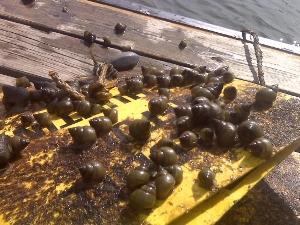Ecological Impact
Species and Environmental Effects
C. chinensis is an invasive species in the United
States and Canada. As an invasive species many studies have
been conducted to determine how C. chinensis affects
the areas it inhabits. In many of the areas that it has invaded
this snail has been able to reach extremely high densities
(Johnson, 2009). Despite the large population densities, the
ecological impact of this species remains inconclusive (Menno Soes, 2011).
One study conducted by Johnson et al. (2009) reported that
C. chinensis invasions have the potential to negatively
impact native snail species. The presence of C. chinensis
can cause declines in native snails due to competition for the
same food source. The relatively large, thick shell of this
organism compared with native species of snails may also provide
greater protection against predation.
This study also looked into the potential for C. chinensis
to alter other aspects of its environment. An increase in the
ratio of total nitrogen to phosphorous in the water column was
observed. This type of change can have a major affect algal
growth (Johnson 2009). All of these findings, however, are on
the community level. Although this study proves that the
potential for impact is present, more research is required to
determine the effects on an entire ecosystem over time.
Health Risks
C. chinensis has also been reported as a vector of some aquatic parasites. Transmission of Angiostrongylus cantonensis in addition to several members of the family Echinostomatidae have been linked to C. chinensis (Menno Soes, 2011). Angiostrongylus cantonensis is a parasitic nematode (roundworm) that can infect humans if a raw or undercooked infected snail is consumed (Hickman, 2009). Echinostomatidae is a family of parasitic flukes that also use snails as an intermediate host to infect vertebrates (Hickman, 2009).
Thanks to its status as an invasive species, and its ability to reach such high densities in some areas, C. chinensis receives a large amount of attention. Collection of this species is closely monitored and documented (USGS, 2009). Research into the exact effects of this organism is ongoing.
If you have any questions or comments please contact me.
Go Home
